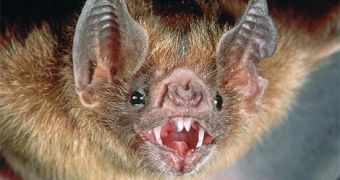There are just three species of blood-sucking bats and just one of vampire bats which attack humans. But even if tiny, this non-Transylvanian Dracula (they live just in tropical America) can still kill you. Not because of the amount of blood it sucks (no more than two little spoons), but by infecting you with rabies. Moreover, the infected bats are not harmed in any way by the rabies, just like we are not (normally) affected by our gut bacteria.
After 12 years of bat-watching on the island of Mallorca, Hevre Bourhy of the Pasteur Institute in Paris and Jordi Serra-Cobo of Barcelona University, discovered that bats can harbor a public health hazard: a virus (EBLV-1) common in these animals that "can cause a fatal illness, indistinguishable from classic rabies, in non-flying mammal species, including humans". Unlike their victims, "the survival model shows no variation in mortality after EBLV-1 infection" in bats.
The virus can trigger frothing-at-the-mouth delirium in "non-flying mammals," but it is largely harmless in bats. This was found in the greater mouse-eared bat (Myotis myotis), the most common European species, native throughout Europe, which feasts just on insects.
The findings "have considerable public health implications ... and confirm the potential risk of rabies transmission to humans."
There is a positive side: Lyssavirus-carrying bats are contagious just for a short period, 5.1 days on average (this may explain the lack of human outbreaks of the disease).
This signals more for protection rather than persecution in the case of the bats.
"The dynamic of bat infection ... supports the decision taken in Europe to protect these animals and not to destroy the colonies in which rabies is present. The only reasonable measure today is to forbid -- as is done in the Balearic Islands -- access to caves harboring bats that might be contagious." said Bourhy.
M. myotis has been so persecuted that now it is considered a threatened species.
Rabies, a deadly infection if untreated, takes a share of 50,000 deaths annually worldwide. Some cases are connected to vampire bats on Latin America, but most infections come from rabid dogs. Other domestic animals, too, can spread the disease. In the last 20 years, there have been just four cases of humans contracting rabies directly from insectivorous bats: one each in Finland, Russia, Ukraine and Scotland.
Besides rabies, bats are known for being a natural reservoir for other new infections, too, like Ebola, but also the Hendra and Nipah viruses, and also possibly the SARS virus.
This research also shows that as humans are increasingly encroaching in the wild habitats, they are more exposed to new biological threats carried by wild animals. In fact, this is how HIV, the plague of our times, jumped from chimps and gorillas to humans. Other older epidemics also originated in animals.

 14 DAY TRIAL //
14 DAY TRIAL // 
